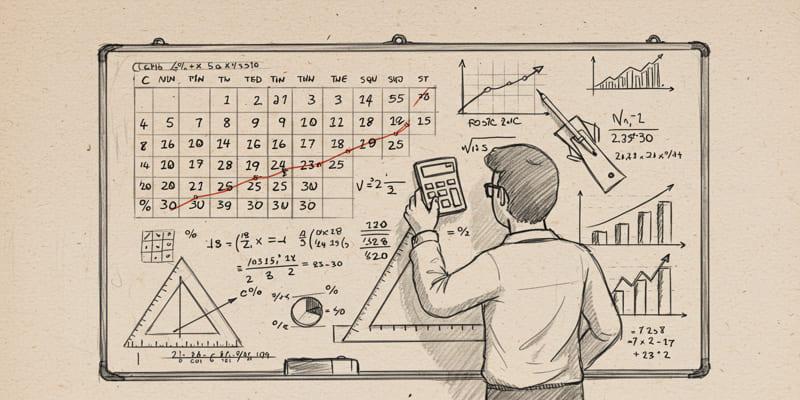The construction of a machine learning model is thrilling, but how can you tell whether it is good-or even better than that previous model? A consistent system of evaluation and comparison of model performance that is ultimately reliable is the key. Finding appropriate metrics and baselines, formalizing benchmarks, and making sure they are reproducible are just a few steps described in this guide so that you can measure progress and deploy with confidence.
What is a Model Benchmark?

Model benchmark A baseline is a standardized procedure of evaluating the output of your machine learning models. It is three-fold, comprising three parts:
- A consistent dataset: A high-quality, representative dataset that is split into training, validation, and testing sets.
- A set of evaluation metrics: Specific, quantifiable measures used to score a model's performance on that dataset.
- A baseline model: A simple, often traditional model that provides a minimum performance threshold to beat.
You can objectively compare the various models which may be variations of the same algorithm or dissimilar architectures by holding the dataset and metrics constant. Systematic elimination of hoarders enables you to monitor progress and prevent retrogression as time elapses, and the systematic model is essential to the process.
Step 1: Curate Your Evaluation Dataset
Good benchmark starts with data upon which evaluation is to be based. This data has to be realistic of what your model is to be exposed to. When your assessment information is defective or not representative, your benchmarks conclusions will be inaccurate.
Sourcing and Cleaning Data
Begin with quality, pertinent data. This could be provided as internal logs or publicly available Datasets or third-party providers. Make sure that data is clean and preprocessed. These include the negative value processing, fixing inaccuracies and standardizing the formatting. There is a principle of garbage in, garbage out; no amount of sophisticated modeling can be used to compensate bad-quality data.
Creating Data Splits
To prevent overfitting and to receive an unbiased performance estimate you should split your data into three different sets:
- Training Set: The largest portion of your data, used to train the model. The model learns patterns and relationships from this set.
- Validation Set: A smaller subset used to tune the model's hyperparameters (like learning rate or tree depth) and make decisions about the model architecture during development.
- Test Set: A separate, untouched dataset that the model has never seen. This set is used only for the final evaluation to provide an unbiased assessment of how the model will perform on new, unseen data.
Avoid profaning the test set is very vital. Use it not to train or tune. This would inform the model inappropriately and result in an overly optimistic performance assessment that would fail to sustain in manufacture. Usually, a typical split is 70/15/15 training / validation / testing, although this may be adjusted based on the sheer size of your general free data.
Step 2: Select the Right Evaluation Metrics

After you have your data, you now must choose what measure of performance you want to make your model perform. The metrics you are taking must need to go directly to the business objectives of your project. What would be the perfect model, according to one parameter, would be a failure according to another.
Common Metrics for Different Tasks
Your mission and misuse of machine learning will heavily depend on the nature of the task that you are about to attempt in this activity.
For Classification Tasks (e.g., spam detection, image recognition):
- Accuracy: The percentage of correct predictions. It's a good starting point but can be misleading for imbalanced datasets.
- F1-Score: The harmonic mean of precision and recall, providing a single score that balances both.
- AUC-ROC Curve: A plot illustrating the balance between the true positive rate and false positive rate, with the Area Under the Curve (AUC) offering a single metric for separability.
For Regression Tasks (e.g., house price prediction, sales forecasting):
- Mean Absolute Error (MAE): The average of the absolute differences between predicted and actual values. It's easy to interpret.
- Mean Squared Error (MSE): The average of the squared differences. It penalizes larger errors more heavily.
- Root Mean Squared Error (RMSE): The square root of MSE, which brings the metric back to the original units of the target variable.
Selecting the appropriate metric is not only a technical choice, but it is a business choice. In a medical diagnosis model, e.g. relation, the recall (telling all sick patients) can be of greater importance than the precision, despite a higher number of false positives.
Step 3: Establish a Strong Baseline
Without a point of reference, you will not know whether your complex deep learning model is warming up or not. Such a fundamental point of comparison is a baseline model. Implementation should be easy and it offers a performance score that any newly developed, more sophisticated model must exceed.
Types of Baselines
Dummy or Random Baseline
This model is the simplest of all possible. In a classification problem it could always grant the most common classification or random predictions. This reference gives an absolute minimum level of performance.
Simple Heuristic
An operational rule based approach, which is on domain knowledge. As an illustration, a customer churn predictive model could be based on a straightforward formula such as, "customers not signing in after 30 days will churn."
A Simple, Traditional Model
Apply a proven, non-complex algorithm such as the Logistic Regression in fields that are classification or Linear Regression in regression problems. Such models are also easy to train, and in several instances, offer a surprisingly high baseline.
It only matters when your new sophisticated model is a lot better than this basic baseline. Otherwise, it will not be worth the additional complexity, expense and effort.
Step 4: Make Your Benchmark Reproducible
A benchmark should be reliable enough in that its scores can be replicated. Reproducibility guarantees that the performance change by its own, rather than random change in an evaluation setup.
How to Ensure Reproducibility
- Version Control Your Code and Data: Use tools such as git and data version control (DVC) to keep track of updates to your code, model configuration and data.
- Fix Random Seeds: The learning of many machine learning algorithms is stochastic in nature. Fixed a random seed in code to make sure data splits, weight initializations and other random processes all match across execution of your code.
- Document Everything: Keep detailed records of your entire benchmarking process. This includes data sources, preprocessing steps, model hyperparameters, software versions, and the exact evaluation metrics used.
- Automate the Pipeline: Create an automated script or pipeline that runs the entire benchmark process—from data loading to model evaluation. This reduces the risk of human error and makes it easy to re-run the benchmark on new models.
Final Thoughts
Ensuring a benchmark that is reliable is a necessity in the machine learning lifecycle. It directs development, confirms findings and creates confidence in models. Through data curation, selection of useful metrics, establishing a high-quality baseline, and reproducibility you establish a base on which continuous improvements can be built. This method takes you out of speculation to knowing and this approach will allow you to create models that stand up technically and ones that provide real world value. Start benchmarking today!











